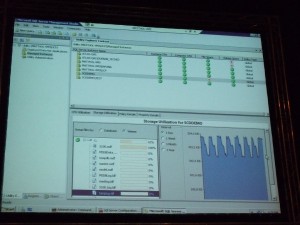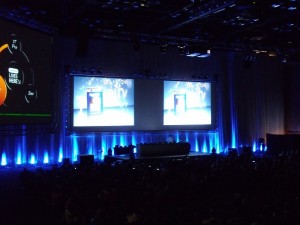The only session that I attended today was Peter Willmot’s level 400 on Extended Events.
Extended events have potentially very low impact, less overhead than Profiler. In fact, in SQL 2008 there’s an extended events session running by default, a health check that has a small number of critical events that it traces Using Extended events needs good xml knowledge in the current version as there’s no built-in GUI. There are a couple 3rd-part apps available for download on Codeplex.
The key portions of Extended events are events (things that occur), actions (what to do when they occur), predicates (to filter to only the ones we’re interested in) and targets (what to do with the info)
Some of the targets (most) are async, some are sync. It is possible to allow events to be missed, in cases where there is too much happening and performance would suffer if all events were captured.
Best practices: Be careful with even retention. More events retained = more overhead. Rather go for the async targets as much as possible. Reduced the waits imposed on the SQL events. Target is async or sync. Predicates are always synchronous.
The closing keynote was way more interesting than the opening was. There were a couple upcoming technologies that they spoke about, then there was a talk on future directions in communication for Africa
AutoCollage. Take a picture library and automatically detect the most representative photos and generate a collage based on those. Face recognition, object detection, complex algorithms.
Natural user interfaces. Video on natural user interfaces. Starts off with stuff that’s not too implausible or too far ahead, gets a little strange towards the end. I have seen that video before, might have been at TechEd last year. After the video they showed that some of this is already in use at Redmond, specifically something called the ‘Executive Wall’, a multi-touch wall that shows information and allows interaction, drill-in and items to be moved around. Apparently Bill Gates demoed it at an executive conference recently.
Communication revolution. Talked about the potential and actual connectivity to the rest of the world. Apparently by 2011 there should be a potential 10 Tb/sec available to South Africa. Potential, because not all the cables will be active immediately. There also looks like there will be some amusing political problems. There are four major players in the whole game. Will be interesting to see how they work together, if they work together.
The future:
- User interfaces evolve. Interoperable
- The cloud will be a reality
- Phone vs Computer won’t go away
- Computers just about everywhere.
- Fiber to the home
- Video-on-demand a reality
- True video conferencing
- Same content regardless of the device
I just wish the future was here in terms of airlines. I was supposed to leave Durban at 17h40. Flight was full due to two cancellations and the new flight’s just been delayed. At this rate I’ll only be getting home tomorrow….






